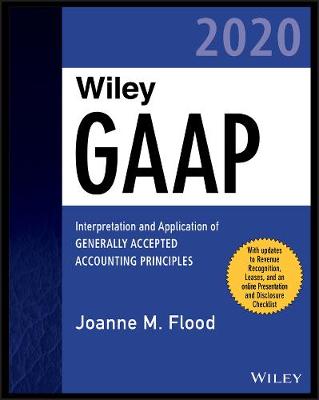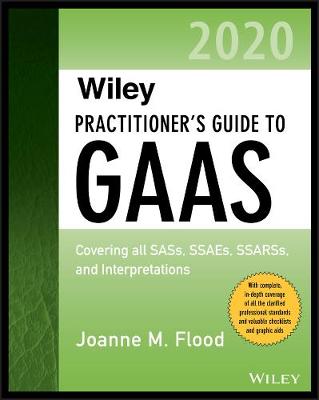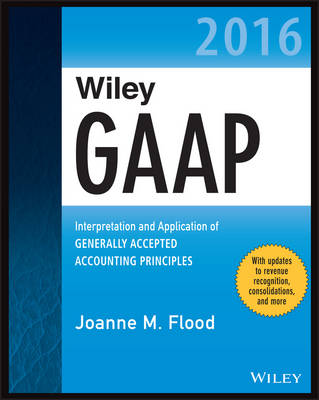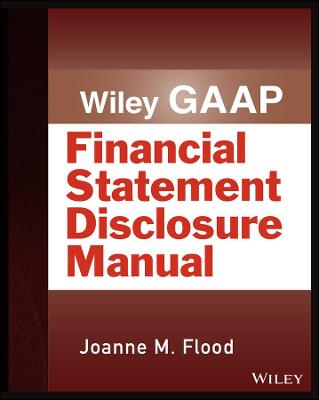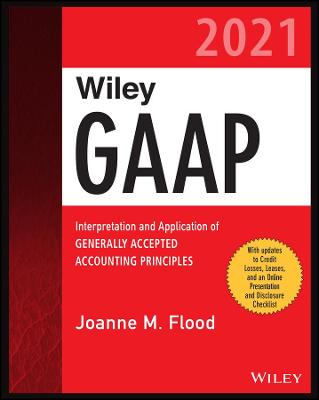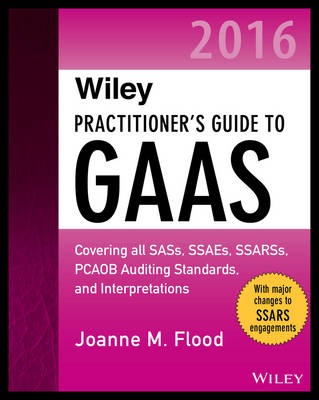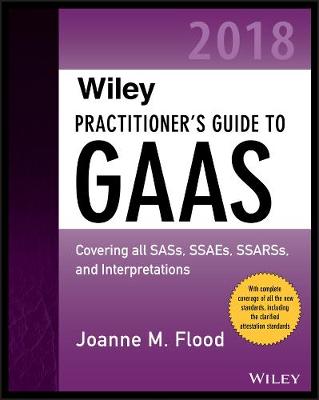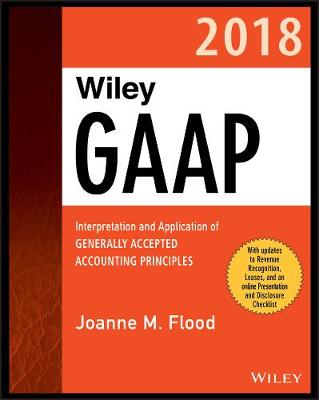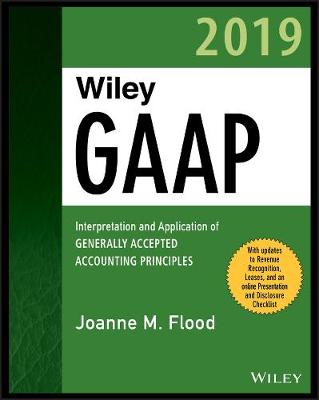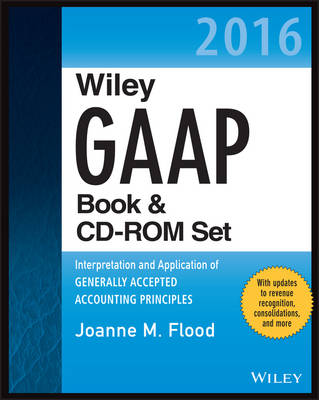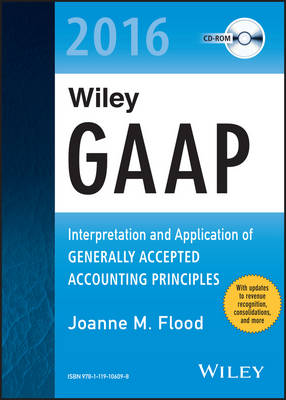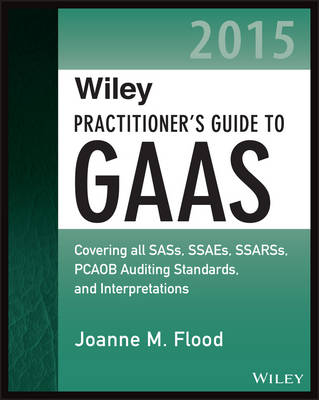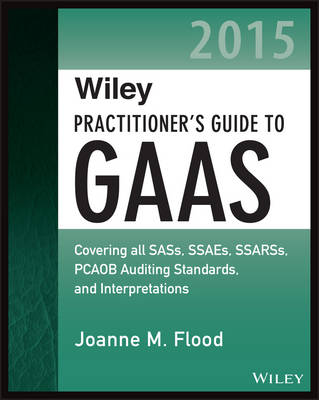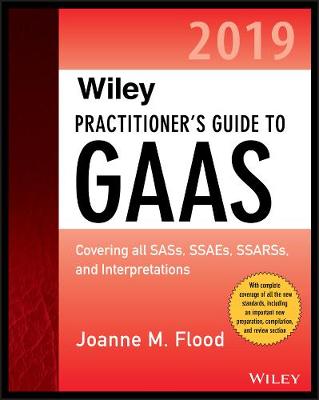Wiley Regulatory Reporting
2 primary works • 25 total works
Book 99
Wiley GAAP 2020 – Interpretation and Application of Generally Accepted Accounting Principles
by Joanne M. Flood
The most comprehensive guide to FASB Codifications, updated with the latest pronouncements Wiley GAAP 2020 is the essential resource for US GAAP implementation. Covering all codifications by the Financial Accounting Standards Board (FASB) - including the latest updates - this book provides clear explanations and practical examples for real-world application of these dynamic guidelines. Each chapter includes relevant sources of GAAP and expert guidance on interpretation, terminology, relevant concepts, and applicable rules, while in-depth discussion on the issues surrounding specific pronouncements offers informative perspective for a variety of scenarios. Staying up-to-date with constantly-evolving guidelines is a challenge. Wiley GAAP 2020 provides the guidance, insight, and perspective accounting professionals need to ensure accurate and up-to-date GAAP implementation.
Book 101
Wiley Practitioner′s Guide to GAAS 2020 – Covering all SASs, SSAEs, SSARSs, and Interpretations
by Joanne M. Flood
A comprehensive guide to GAAS for 2020, covering critical auditing standards, practices, and procedures
Over the last few years, the AICPA has clarified all its professional standards, raising challenges for the accounting professional to stay current and in compliance. This edition will give auditors and accountants the knowledge and understanding they will need to competently perform and successfully complete their engagements. With this valuable resource, readers will have a comprehensive guide to the latest professional standards, practices, and procedures. The Wiley Practitioner's Guide to GAAS 2020 provides an analysis of all SASs, SSAEs, SSARSs, and Interpretations. This one book provides all the most recent revisions to the standards, explaining them in a clear way that's designed for greater understanding.
Whenever standards are changed, professionals need guidance on conducting engagements efficiently and effectively. This guide to GAAS and other professional standards provides helpful, systematic direction that saves auditors and accountants time and supports them in their jobs. Readers will have a comprehensive view of moving through the process of auditing, reviewing, compiling, and preparing financial statements and performing attestation services. In addition to explanations, readers will get a detailed discussion of current issues and gain the benefits of practice notes, illustrations, checklists, and questionnaires to reference. Practitioners will find:
- Organization based on the way auditors use the Statements on Auditing Standards, ensuring efficiency and ease of navigation
- Comprehensive guidance through the auditing process
- Explanations of all attestation standards
- Updates and interpretations of Statements on Standards for Accounting and Review Services
The Wiley Practitioner's Guide to GAAS 2020 is a fully updated resource for completing audit, attestation, review, compilation, and preparation engagements successfully.
Wiley Financial Reporting Framework for Small and Medium-Sized Entities
by Joanne M. Flood
Wiley Financial Reporting Framework for Small and Medium Sized Entities: Interpretation and Application presents the set of new criteria used to determine measurement, recognition, presentation, and disclosure of all material items appearing in the financial statements for privately held SMEs.
Wiley GAAP 2015 contains the most comprehensive coverage of all GAAP pronouncements in a single volume, providing professionals with a complete reference to the entire GAAP hierarchy. This new edition includes the latest updates to the standards, along with AICPA ASEC statements of position and a comprehensive cross-reference of accounting topics to the new FASB codification system. All pronouncements are fully explained in detail, including terminology, and practice exercises demonstrate real-world application. Each chapter includes a discussion of perspectives and issues, sources of GAAP, definitions, concepts, rules, and examples, with specific appendices where applicable. This useful guide contains more examples and illustrations than any other GAAP reference, and all original pronouncements are referenced to the FASB Current Text.
GAAP is constantly being updated, and users require expert interpretation and explanation of relevant principles with every new pronouncement. This book provides clear, user-friendly guidance, including FASB Technical Bulletins, AcSEC Practice Bulletins, FASB Implementation Guides, and AICPA Statements of Position and Accounting Interpretations. Readers will:
- Refer to GAAP standards and ASEC statements quickly and easily
- Understand relevant terminology, concepts, and rules
- Study detailed examples to gain a solid working knowledge of the standards
- Gain confidence by practicing GAAP applications before using it in the field
This guide represents the most complete, comprehensive GAAP reference available, and the digital format allows for instant access to needed information through the point-and-click index and Table of Contents. Busy professionals need to get up to speed quickly without sacrificing a solid understanding, and Wiley GAAP 2015 is the essential user-friendly reference.
Wiley GAAP 2016 contains the most comprehensive coverage of all GAAP pronouncements in a single volume, providing professionals with a complete reference to the entire GAAP hierarchy. This new edition includes the latest updates to the standards, along with AICPA ASEC statements of position and a comprehensive cross-reference of accounting topics to the new FASB codification system. All pronouncements are fully explained in detail, including terminology, and practice exercises demonstrate real-world application. Each chapter includes a discussion of perspectives and issues, sources of GAAP, definitions, concepts, rules, and examples, with specific appendices where applicable. This useful guide contains numerous examples and illustrations, and all original pronouncements are referenced to the FASB Current Text.
GAAP is constantly being updated, and users require expert interpretation and explanation of relevant principles with every new pronouncement. This book provides clear, comprehensive guidance, including FASB Technical Bulletins, AcSEC Practice Bulletins, FASB Implementation Guides, and AICPA Statements of Position and Accounting Interpretations. Readers will:
- Refer to GAAP standards and ASEC statements
- Understand relevant terminology, concepts, and rules
- Study detailed examples to gain a solid working knowledge of the standards
- Gain confidence by practicing GAAP applications before using it in the field
This guide represents the most complete, comprehensive GAAP reference available, and the digital format allows for instant access to information through the point-and-click Index and Table of Contents. A thorough study and analysis of all US Generally Accepted Accounting Principles, Wiley GAAP 2016 is the essential reference.
The clearest, easiest-to-use guide to understanding all the clarified standards, including the new attestation standards—fully updated!
This comprehensive guide to understanding Generally Accepted Auditing Standards (GAAS) is not just about auditing. It addresses the toughest part of an accountant's job—identifying, interpreting, and applying the many audit, attest, review, compilation, and preparation standards relevant to a particular engagement.
Wiley Practitioner's Guide to GAAS 2017 offers a clear and accessible distillation of the official language of GAAS, Statements on Standards for Attestation Engagements (SSAEs), and Statements on Standards for Accounting and Review Services (SSARSs)—as well as advice on exactly how to remain fully compliant with each.
Wiley Practitioner's Guide to GAAS 2017 is organized according to the logical arrangement of the clarified standards, presenting each section individually, and explaining how it is related to the engagement process. Guidance is offered on the entire process, in the form of practice notes, checklists, questionnaires, and real-world examples, illustrating how the fundamental requirements of each section are applied.
Other key features include:
- A brief identification of each auditing, SSAE, and SSARS section, with effective dates and tips on how to apply it
- Highlights of new requirements in the clarified attestation standards
- Concise listing and descriptions of each section's specific mandates, including definitions
- Easy-to-read capsule summary of interpretations, plus selected technical alerts
- Helpful techniques for remaining compliant with each standard
New in GAAS 2017:
In 2016, the AICPA's Auditing Standards Board completed a major stage of its clarity project and issued SSAE No. 18. The new guidance is effective for reports dated May 1, 2017. SSAE No. 18 replaces the attestation standards, introducing major new requirements that will change practice. In this transition year, guidance on the extant attestation standards is also included. Wiley Practitioner's Guide to GAAS 2017 is completely updated to reflect all the clarified standards and provide valuable implementation information.
Wiley Revenue Recognition plus Website – Understanding and Implementing the New Standard
by Joanne M. Flood
Wiley Revenue Recognition provides an overview of the new revenue recognition standard and instructs financial statement preparers step-by-step through the new model, providing numerous, helpful application examples along the way. Readers will grasp the many new disclosures that will be required through the use of detailed explanations and useful samples, while electronic tools will be available to aid the preparer in implementing the standards and making the proper disclosures.
The Financial Accounting Standards Board (FASB) and the International Accounting Standards Board (IASB) are in the final stages of a decade-long project to clarify and converge revenue recognition standards. This new principles-based standard--which will affect the business practices of virtually every company worldwide--is designed to serve as one model applied consistently across most industries. This book guides professionals through the new standard.
- Offers a full explanation of over forty topics superseded by the new standard
- Includes digital ancillaries featuring measurement tools and GAAP and IFRS Disclosure Checklists
- Provides all the tools needed to implement the new revenue recognition standard
- Covers how the structure of contracts will be affected
Wiley Revenue Recognition is a trusted, authoritative guide to the new FASB-IASB revenue recognition standard for CPAs and financial professionals worldwide.
Wiley GAAP 2017 contains complete coverage of the Financial Accounting Standards Board's (FASB) Accounting Standards Codification (ASC), the source of authoritative generally accepted accounting principles (GAAP). Wiley GAAP renders GAAP more understandable and accessible for research and has been designed to reduce the amount of time and effort needed to solve accounting research and implementation issues.
The 2017 edition reflects the new FASB guidance on:
- Revenue Recognition
- Leases
- Business Combinations
- Pensions
- Financial Instruments
- And more than 17 other new FASB Accounting Standards Updates
Providing interpretive guidance, analytical explanations, graphic tools, and more than 300 real-world, examples and illustrations, this invaluable guide offers clear, user-friendly guidance on every ASC Topic in the Codification.
- Offers insight into the application of complex financial reporting rules
- Contains a detailed index for easy reference use
- Includes comprehensive cross-referencing to the FASB codification system, making it efficient for you to perform in-depth research
As a bonus, a comprehensive disclosure checklist offers practical guidance to preparing financial statements for commercial entities in accordance with GAAP. For easy reference and research, the checklist follows the order of the codification.
With easy-to-access information, this reliable resource offers complete coverage of the FASB Codification.
Wiley GAAP – Financial Statement Disclosures Manual
by Joanne M. Flood and Teresa C. Anderson
This book is a guide to enhanced disclosure as standardized by FASB, and works in conjunction with other Wiley GAAP products to provide a complete professional reference. * Find specific GAAP codification and explanations quickly and easily * Get up to speed on the latest developments and updates * Follow references to relevant content in Wiley GAAP and the Disclosure Checklist * Study expertly-prepared examples to understand GAAP applications Enhanced disclosure requirements have come about in response to accounting scandals, the proliferation of complicated instruments, and the pressure toward transparency. Keeping abreast of the latest developments and their applications and requirements is an essential but time-consuming part of the accountant's role. Financial Statement Disclosures Manual simplifies statement preparation by providing complete disclosures information, cross-referenced to relevant GAAP information and tools.
* Detailed explanation of all new SAS standards * Updates and interpretations of new Statements on Standards forAccounting and Review Services (SSARS) Compilation and Reviewstatements * A brief identification of each SAS, SSAE, and SSARS, with itseffective date and tips on when to apply it * A convenient and comprehensive glossary of officialdefinitions, which are usually scattered throughout a standard * Behind-the-scenes explanations of the reasons for eachpronouncement and brief explanations of the basic ideas of thesection * Concise listing and descriptions of each standard's specificmandate * Easy-to-read capsule summary of interpretations, plus selectedAICPA practice alerts and advisories * Helpful techniques for remaining compliant with eachstandard * Examples and illustrations for testing internal controls Wiley Practitioner's Guide to GAAS 2014 presents eachstatement individually, explaining how the standards are relatedand offering guidance on the entire engagement process in the formof practice notes, checklists, questionnaires, and real-worldexamples that illustrate how the fundamental requirements of eachsection are applied.
Wiley GAAP 2021 – Interpretation and Application of Generally Accepted Accounting Principles
by Joanne M. Flood
The most comprehensive guide to US GAAP—thoroughly updated to reflect the latest pronouncements
US GAAP is constantly being updated, requiring its users to be armed with expert interpretation and explanation of the relevant principles. Wiley GAAP 2021 provides the most complete coverage of all Financial Accounting Standards Board (FASB) Topics – including the latest updates.
Each chapter includes discussion of perspectives and issues, sources of GAAP, practice-oriented examples, and accurate definitions of terms, concepts, and rules. Every FASB Topic is fully explained in a clear, reader-friendly way with dynamic graphics to aid in understanding complex topics. Extensively updated to reflect all current US GAAP changes, this indispensable book:
- Reviews the latest changes to accounting principles, including credit losses, inventory, financial instruments, leases, and revenue
- Offers expert guidance on issues surrounding specific pronouncements
- Includes comprehensive cross-references and topic-specific appendices
- Explains how the standards apply to common real-world scenarios
- Clarifies implementation through numerous illustrations and practical examples
Accurate and up-to-date GAAP implementation is crucial for eliminating the risk of noncompliance. Wiley GAAP 2021 is your one-stop resource for staying up-to-date with constantly-changing guidelines—providing the insight and guidance accounting professionals need.
Wiley Practitioner's Guide to GAAS 2016 provides full guidance toward the latest guidelines and applications of Generally Accepted Auditing Standards. With detailed coverage of the newest releases, this helpful reference explains each standard in clear, accessible language and highlights the ways in which the standards are related. Organized for easy navigation, each statement is presented individually along with explanation, practice notes, practical illustrations, checklists and questionnaires to guide you through the auditing process. The book is written to align with the Statements on Auditing Standards, and includes updates and interpretations of all new Statements for Accounting and Review Services Compilation and Review statements to help you ensure a complete and fully compliant audit.
Accounting standards are critical to the auditing process, but frequent revisions and new releases add a layer of complexity to compliance. This book provides interpretation and application notes for all GAAS standards, including all SASs, SSAEs, SSARSs and PCAOB.
- Get up to speed on the latest GAAS standards
- Walk through each statement step-by-step
- Utilize helpful tools to ensure full compliance
- Gain a deeper understanding of each standard's applications
Identifying, interpreting, and applying the many standards relevant to a particular engagement can be the most difficult part of the auditor's job. This guide simplifies the process by combining the standards, explanations, tools, and expert advice into a single, easily navigated volume. For the auditor who needs to be up to date, Wiley Practitioner's Guide to GAAS 2016 presents clear, plain-language guidance toward the most recent GAAS standards, to help you find —and understand — the answers you need quickly.
The clearest, easiest-to-use guide to understanding all the clarified standards, including the new attestation standards—fully updated!
This comprehensive guide to understanding Generally Accepted Auditing Standards (GAAS) is not just about auditing. It addresses the toughest part of an accountant's job—identifying, interpreting, and applying the many audit, attest, review, compilation, and preparation standards relevant to a particular engagement.
Wiley Practitioner's Guide to GAAS 2018 offers a clear and accessible distillation of the official language of GAAS, Statements on Standards for Attestation Engagements (SSAEs), and Statements on Standards for Accounting and Review Services (SSARSs)—as well as advice on exactly how to remain fully compliant with each.
Wiley Practitioner's Guide to GAAS 2018 is organized according to the logical arrangement of the clarified standards, presenting each section individually, and explaining how it is related to the engagement process. Guidance is offered on the entire process, in the form of practice notes, checklists, questionnaires, and real-world examples, illustrating how the fundamental requirements of each section are applied.
Other key features include:
- A brief identification of each auditing, SSAE, and SSARS section, with effective dates and tips on how to apply it
- Highlights of new requirements in the clarified attestation standards
- Concise listing and descriptions of each section's specific mandates, including definitions
- Easy-to-read capsule summary of interpretations, plus selected technical alerts
- Helpful techniques for remaining compliant with each standard
Wiley GAAP 2019 is the essential resource for US GAAP implementation. Covering all codifications by the Financial Accounting Standards Board (FASB)—including the latest updates—this book provides clear explanations and practical examples for real-world application of these dynamic guidelines. Each chapter includes relevant sources of GAAP and expert guidance on interpretation, terminology, relevant concepts, and applicable rules, while in-depth discussion on the issues surrounding specific pronouncements offers informative perspective for a variety of scenarios.
This user-friendly reference covers every pronouncement currently in effect or being deliberated—including FASB Technical Bulletins, FASB Implementation Guides, AcSEC Practice Bulletins, and AICPA Accounting Interpretations—in a single volume, fully referenced to the FASB Current Text and cross-referenced to the new FASB codification system. Clear and concise without sacrificing depth or rigor, this invaluable resource simplifies research and helps CPAs and other accounting professionals ensure accuracy and compliance.
Examine the latest changes to US GAAP standards and practices
Gain expert perspectives on the issues surrounding specific pronouncements
Learn how the standards translate to common real-world scenarios
Clarify implementation through numerous illustrations and real-world examples
Staying up-to-date with constantly-evolving guidelines is a challenge, but the requirement for accurate interpretation and appropriate application adds an additional layer of complexity in an area where noncompliance could expose an organization to significant risk. Wiley GAAP 2019 provides the guidance, insight, and perspective accounting professionals need to ensure accurate and up-to-date GAAP implementation.
Wiley GAAP 2016: Interpretation and Application of Generally Accepted Accounting Principles Set
by Joanne M. Flood
This book provides clear, comprehensive guidance, including FASB Technical Bulletins, AcSEC Practice Bulletins, FASB Implementation Guides, and AICPA Statements of Position and Accounting Interpretations. Readers will: * Refer to GAAP standards and ASEC statements * Understand relevant terminology, concepts, and rules * Study detailed examples to gain a solid working knowledge of the standards * Gain confidence by practicing GAAP applications before using it in the field This guide represents the most complete, comprehensive GAAP reference available, and the digital format allows for instant access to information through the point-and-click Index and Table of Contents. A thorough study and analysis of all US Generally Accepted Accounting Principles, Wiley GAAP 2016 is the essential reference.
Wiley GAAP 2016: Interpretation and Application of Generally Accepted Accounting Principles CD–ROM
by Joanne M. Flood
This software product is sold as is without warranty of any kind, either express or implied, including but not limited to the implied warranty of merchantability and fitness for a particular purpose. Neither Wiley nor its dealers or distributors assumes any liability for any alleged or actual damages arising from the use of or the inability to use this software. (Some states do not allow the exclusion of implied warranties, so the exclusion may not apply to you.)
Wiley Practitioner's Guide to GAAS 2015 is a complete reference for the auditing professional, logically organized to allow for quick navigation. * Understand the real-world application of each standard * Learn each standard's effective date and specific mandates * Examine technical alerts, definitions, and interpretations * Develop techniques for maintaining compliance Identifying, interpreting, and applying the many standards relevant to a particular engagement can be the most difficult part of the auditor's job. This guide simplifies the process by combining the standards, explanations, tools, and expert advice into a single, easily navigated volume. For the auditor who needs to be up to date, Wiley Practitioner's Guide to GAAS 2015 provides the latest on GAAS compliance.
The definitive reference for clarified standards application and compliance, fully updated for 2019
The Wiley Practitioner's Guide to GAAS 2019 is the comprehensive and user-friendly guide to Generally Accepted Auditing Standards. Fully updated to reflect all new standards, practices, and statements—including Statements on Standards for Accounting and Review Services (SSARS) and Statements on Standards for Attestation Engagements (SSAE)—this essential resource offers practitioners a clear and complete reference in a single volume. This book provides complete coverage of relevant areas including audit planning and documentation, audit evaluation and evidence, examination and review engagements, and more to help auditors interpret and apply current auditing standards while maintaining full compliance with GAAS.
General auditing standards are subject to frequent updates and divergent interpretations, yet practitioners need to keep pace with the latest changes if compliance is to be maintained. Employing a logical organizational structure, this guide defines and interprets each clarified standard and explains its relation to the engagement process. Practice notes, checklists, questionnaires, and relevant real-world examples demonstrate how each section is applied. This indispensable resource provides in-depth guidance on GAAS interpretation, application, and compliance to help you:
- Identify and apply each auditing, SSAE and SSARS section
- Understand new requirements in clarified attestation standards
- Access technical alerts, interpretation summaries, and individual section descriptions and definitions
- Employ techniques to maintain compliance with each standard
TheWiley Practitioner's Guide to GAAS 2019 provides auditing professionals with the expert guidance and up-to-date information necessary to save you time, streamline your workload, and maximize your job performance.
